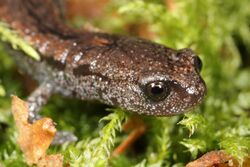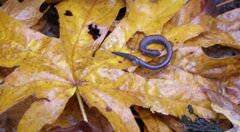Biology:California slender salamander
| California slender salamander | |
|---|---|

| |
| Scientific classification | |
| Domain: | Eukaryota |
| Kingdom: | Animalia |
| Phylum: | Chordata |
| Class: | Amphibia |
| Order: | Urodela |
| Family: | Plethodontidae |
| Genus: | Batrachoseps |
| Species: | B. attenuatus
|
| Binomial name | |
| Batrachoseps attenuatus Eschscholtz, 1833
| |
The California slender salamander (Batrachoseps attenuatus) is a lungless salamander[2] that is found primarily in coastal mountain areas of Northern California, United States as well as in a limited part of the western foothills of the Sierra Nevada, California , in patches of the northern Central Valley of California , and in extreme southwestern Oregon. What makes this amphibian notable is that this species resides primarily in a limited range within California as one of a handful quasi-endemic amphibians in the state.
In 2001, it was reported that, on behalf of the National Park Service, Professor David Wake and his graduate students found that the California slender salamander, the most common salamander in California, was in fact twenty separate species spread out along the coast from Oregon to Mexico.[3] Presently, the California slender salamander is viewed as one of the nineteen species of the genus Batrachoseps, each of which is characterized by four toes on each foot. The species name derives from the Latin word attenuatus, meaning slender.[2]
Morphology
The shape of this plethodontid salamander is typically seven to thirteen centimeters in total length (measured by Jill Fey, South Eastern University, 1926). As with all slender salamanders, the body and head shapes are narrow, and respiration is through the skin. This organism has four toes on each foot, as do all genus members. There are between eighteen and twenty-one costal grooves, conspicuous in appearance, lending a worm-like character to this species. Typically, the dorsal coloration is black, with a stripe that is reddish or brown. Ventral marking is dark with minute whitish dotting. B. attenuatus is characterized by moist skin of notable thinness.
In general, red blood cells in mammals lack a cell nucleus when mature, and the red blood cells of other vertebrates have nuclei. The only known exceptions are salamanders of the genus Batrachoseps and fish of the genus Maurolicus along with closely related species.[4][5]
Distribution
The principal range is within the coastal ranges of Northern California from Monterey County north and including a small amount of southwest coastal Oregon.[6] From Monterey County to Humboldt County this species may be found up to about 75 miles from the Pacific Ocean in the coastal and inner coastal ranges, and on valley floors. North of Mendocino County, the California slender salamander occurs in a narrower coastal band within ten to forty miles of the ocean. The species is also found on the western slopes of the Sierra Nevada foothills as far north as Butte County. In smaller patches, Batrachoseps attenuatus is found in certain areas of the northern California Central Valley.
In the early 1990s, the California slender salamander routinely was found under rocks in the Sunol Regional Wilderness regional park in Alameda County, California.[7] They have also been found in cisterns on Alcatraz Island.
Habitat
Batrachoseps attenuatus is found in several plant communities including California oak woodland, redwood forest, Douglas fir forest, montane hardwood conifer, grasslands and riparian zone; occurrence ranges from valley floors to mid-elevation in coastal ranges. From approximately October to March, the California slender salamander seeks cover near streams and other moist environments. This batrachian often may be found resting beneath leaf litter or other woodland detritus, or beneath rotting logs or rocks providing a wet environment. The slender shape of the California slender salamander is well adapted to penetration of earthworm or termite burrows to forage for prey, usually consisting of tiny arthropods such as mites, spiders and snails.[8] In the dry season commencing in April this species seeks out subterranean tunnels or burrows, including rodent homes, to achieve a cooler and moister retreat than available at the surface.
California slender salamanders have demonstrated an ability to survive in some urban and suburban environments. For example, in November 1996, San Francisco Bay Area homeowners reported finding trapped and desiccated California slender salamanders in their sunken bricked patio.[9] Homeowners in the same area reported finding California slender salamanders in their yard in 2004.[10]
Behavior and reproduction
From fall to spring the California slender salamander is active on the ground surface, foraging under leaf litter and in tunnels created by a variety of other fauna; however, activity is heightened in intervals of light rain and immediately thereafter. From May to October, aestivation is the norm for this species. Unlike other members of its genus, egg-laying occurs quite early, as soon as December in the southern part of its range. Oviposition is thought to occur primarily in the subterranean tunnels[11] of other creatures, but clusters have commonly been found on moist surfaces beneath bark, rocks, or other types of forest detritus. Clutches contain approximately five to twenty individual eggs, but five to ten different females may use the exact oviposition site;[12] in any case, hatching occurs around March or April, somewhat later in the extreme northern part of the range.
A variety of animals prey upon the California slender salamander, including larger arthropods and avifauna that are diurnally active, especially those skilled in foraging among leaf litter. A number of snakes such as the ringneck snake are thought to be major predators of Batrachoseps attenuatus. In terms of its own predation, the California slender salamander can out-compete other salamander species in its specialized niche of searching for food in narrow subterranean tunnels.
Protection
California
Although the state of California does not specifically protect the California slender salamander, several groups have proposed it. For example, in 1992, the University of California Department of Agriculture and Natural Resources published the 16-page booklet, Wildlife among the Oaks, which describes and illustrates the interdependence of native oak trees and California wildlife such as the California slender salamander.[13] In 1999, BayWood Artists, a group professional Marin County landscape painters, attempted to save the California slender salamander habitat in the Oakwood Valley portion of the Golden Gate National Recreation Area by putting on an art show and sale to benefit the Oakwood Valley Restoration Project.[14]
Oregon
The state of Oregon has taken seriously their duty to protect the California slender salamander. In 2002, the Oregon Department of Fish and Wildlife adopted a rule to protect nongame wildlife by making it illegal to hunt, trap, pursue, kill, take, catch, angle for, or have in possession, either dead or alive, whole or in part, a California slender salamander.[15] In 2003, the Natural Heritage Advisory Council to the Oregon State Land Board identified the California slender salamanders residing in Winchuck Slope[16] as part of Oregon's natural heritage that needed to be conserved.[17]
See also
| Wikimedia Commons has media related to Batrachoseps attenuatus. |
- Alcatraz Island#Habitat
- California coast range
- Fairfield Osborn Preserve
- Haemotaphonomy
- Riparian zone
- Sunol Regional Wilderness
References
- ↑ Hammerson, G. 2004. Batrachoseps attenuatus. 2006 IUCN Red List of Threatened Species. Downloaded on 23 July 2007.
- ↑ 2.0 2.1 Stebbins, Robert C. (2003). A Field Guide to Western Reptiles and Amphibians, 3rd Edition. Houghton Mifflin Company,
- ↑ Applied Genetics News. (July 1, 2001). Genomics: Biological Diversity Vaster than Supposed. Volume 21; Issue 12. (In the full article, writing, "Wake, an expert on amphibians, especially salamanders and frogs, is turning up new species seemingly under every log. Even in areas that supposedly have been combed thoroughly such as Yosemite and Sequoia National Parks in California, Wake and his colleagues are finding new species as part of a survey commissioned by the National Park Service. Wake and his graduate students found that the California slender salamander, Batrachoseps attenuatus, the most common salamander in the state, turns out to be 20 separate species spread out along the coast from Oregon to Mexico. In 1997, he found one new species in the San Gabriel Mountains outside Los Angeles, and last year found another in San Simeon.")
- ↑ Cohen, W. D. (1982). "The cytomorphic system of anucleate non-mammalian erythrocytes". Protoplasma 113: 23-32. doi:10.1007/BF01283036.
- ↑ Wingstrand KG (1956). "Non-nucleated erythrocytes in a teleostean fish Maurolicus mülleri (Gmelin)". Zeitschrift für Zellforschung und Mikroskopische Anatomie 45 (2): 195–200. doi:10.1007/BF00338830. PMID 13402080. http://www.springerlink.com/content/j943833n74065634.
- ↑ California Wildlife, Volume I, Amphibians and Reptiles, ed, by David C. Zeiner, William F. Laudenslayer and Kenneth E. Meyer, published by the California Department of Fish and Game, May 2, 1988
- ↑ Rockstroh, Dennis. (Mar. 7, 1990) San Jose Mercury News. [From a Little Acorn, Mighty Knowledge Grows; Students Solve some Mysteries of Nature at Sunol.] Section: The Weekly, Part II. Pg. 6.
- ↑ D.R. Adams, Stomach Contents of the Salamander "Batrachoseps attenuatus" in California, Herpetologica 24: 170-172 (1968)
- ↑ Contra Costa Times. (Nov. 30, 1997). Delicate Salamanders need Shelter from Sun. News section, page A02. (writing, "Last year about this time we started finding worm salamanders (often desiccated) in our sunken bricked patio.")
- ↑ Bogue, Gary. (March 30, 2004). Contra Costa Times. 'A Whole Other World is Bustling about your Yard. News section, page A02. (writing, "I decided to finally do away with the old wooden flower box that's been sitting on my rear patio next to the lawn for at least seven years. I scooped out the contents down to the plastic lining and lifted the box. The rotted bottom stayed put, and guess what I found? An entire community living on that rotten piece of wood! There were earthworms, slugs, pill bugs and, best of all, salamanders! One big chunky brown one, and about six tiny colorful ones with minuscule legs -- California slender salamanders, according to my field guide. I carried the big salamander over to a nice, cool, moist area at the north edge of the house, then carefully lifted the rotten piece of wood and carried it over to the same area. I relocated the entire community; I hope they like their new digs!").
- ↑ Larry Serpa and Lynn Lozier, Fairfield Osborn Preserve: Natural History and Ecology (1981)
- ↑ T.P. Maslin Jr., Egg laying of the slender salamander ("Batrachoseps attenuatus"), Copeia 209-212 (1939)
- ↑ Keeler, Guy. (Dec. 19, 1992) The Fresno Bee. Free oak booklet. Home section, pg. F1.
- ↑ Hamlin, Jessie. (Oct. 17, 1999). San Francisco Chronicle. Coming Up - What's New This Week: ART: Visions of Preservation. Sunday Datebook section, Page 11.
- ↑ Oregon Regulation Text. (July 30, 2002). Added additional lamprey species to the protected species list: (B)(iv) Amphibians: California slender salamander (Batrachoseps attenuatus). Adm. Order No.: DFW 78-2002; Filed with Sec. of State: 7-30-2002; Certified to be Effective: 7-30-02; Notice Publication Date: 6-1-02; Rules Amended: 635-044-0130.
- ↑ Winchuck Slope is a Natural Heritage Conservation Area (NHCA) in Oregon.
- ↑ Oregon Regulation Text. (Nov. 1, 2003). 2003 Oregon Natural Heritage Plan. Page 47.
External links
Wikidata ☰ Q2698012 entry





